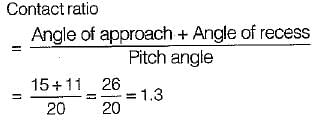Mechanical Engineering Exam > Mechanical Engineering Tests > Test: Toothed Gearing - 1 - Mechanical Engineering MCQ
Test: Toothed Gearing - 1 - Mechanical Engineering MCQ
Test Description
10 Questions MCQ Test - Test: Toothed Gearing - 1
Test: Toothed Gearing - 1 for Mechanical Engineering 2025 is part of Mechanical Engineering preparation. The Test: Toothed Gearing - 1 questions and answers have been prepared
according to the Mechanical Engineering exam syllabus.The Test: Toothed Gearing - 1 MCQs are made for Mechanical Engineering 2025 Exam.
Find important definitions, questions, notes, meanings, examples, exercises, MCQs and online tests for Test: Toothed Gearing - 1 below.
Solutions of Test: Toothed Gearing - 1 questions in English are available as part of our course for Mechanical Engineering & Test: Toothed Gearing - 1 solutions in
Hindi for Mechanical Engineering course.
Download more important topics, notes, lectures and mock test series for Mechanical Engineering Exam by signing up for free. Attempt Test: Toothed Gearing - 1 | 10 questions in 30 minutes | Mock test for Mechanical Engineering preparation | Free important questions MCQ to study for Mechanical Engineering Exam | Download free PDF with solutions
Test: Toothed Gearing - 1 - Question 1
For an involute gear, the ratio, pitch circle radius/ base circle radius is (φ is the pressure angle)
Detailed Solution for Test: Toothed Gearing - 1 - Question 1
Test: Toothed Gearing - 1 - Question 2
Th e tooth profile most commonly used in gear drive for power transmission is
Detailed Solution for Test: Toothed Gearing - 1 - Question 2
Detailed Solution for Test: Toothed Gearing - 1 - Question 3
Detailed Solution for Test: Toothed Gearing - 1 - Question 4
Test: Toothed Gearing - 1 - Question 5
If angle of approach, pitch angle and angle of recess is given by 11°, 20° and 15° respectively, what is the contact ratio of gear?
Detailed Solution for Test: Toothed Gearing - 1 - Question 5
Detailed Solution for Test: Toothed Gearing - 1 - Question 6
Test: Toothed Gearing - 1 - Question 7
If a reduction ratio of about 50 is required in a gear drive then the most appropriate gearing would be
Detailed Solution for Test: Toothed Gearing - 1 - Question 7
Detailed Solution for Test: Toothed Gearing - 1 - Question 8
Detailed Solution for Test: Toothed Gearing - 1 - Question 9
Test: Toothed Gearing - 1 - Question 10
The motion transmitted between the teeth of two spur gears is generally
Detailed Solution for Test: Toothed Gearing - 1 - Question 10
Information about Test: Toothed Gearing - 1 Page
In this test you can find the Exam questions for Test: Toothed Gearing - 1 solved & explained in the simplest way possible.
Besides giving Questions and answers for Test: Toothed Gearing - 1, EduRev gives you an ample number of Online tests for practice
Download as PDF
















